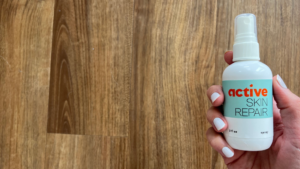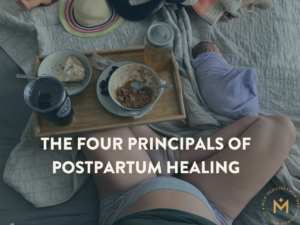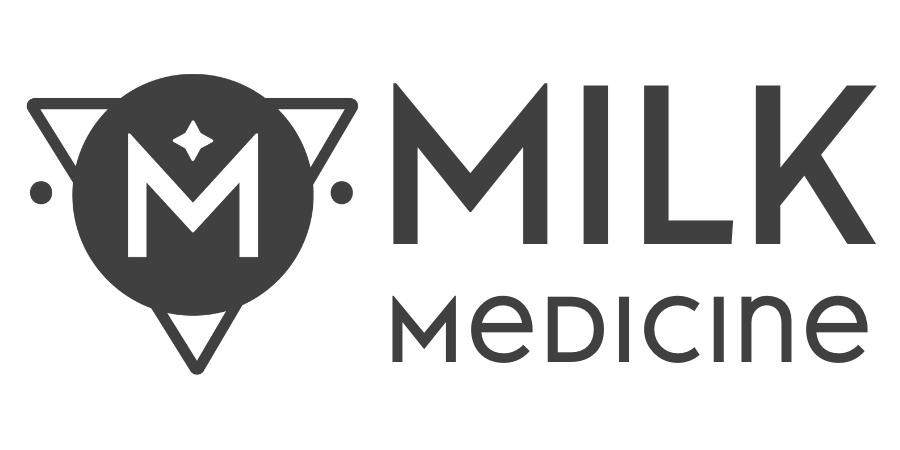Preparing for postpartum is one of the most underrated yet impactful things you can do to influence your experience of new motherhood in a positive way. That’s a big claim, and I stand behind it through and through. Perhaps you’re already well-versed in postpartum healing and have a good sense of what’s to come, but maybe you’re not. Maybe you hadn’t thought about anything past giving birth yet, since that’s a very exciting and potentially nerve wracking event coming up on your calendar. How women prepare (or don’t) for the postpartum time period differs throughout the world.
Let’s dive into where we stand as a culture currently, then hit where we came from historically – and how the nature of the care has shifted. It’s an important, and sadly stark difference that we need to honor in order to move forward with healthier goals. Then, let’s go over the principles of postpartum preparation and healing so that you can begin to build your resources and support systems now – and then when your baby comes, you’re able to soak up the bonding and skin-to-skin snuggles as much as possible. Ok, here we go!
Understandably, there is a lot of societal buzz and attention around pregnant women – shopping for the baby, preparing a nursery, baby showers, and getting ready for the big day of birth. Pregnancy is a sacred time for any family, especially first time parents who are learning as they go along. Birth preparation has finally entered the conversation on a cultural level, and for that we are very excited, as it used to be that many families “went in blind” hoping for the best. But now the options for birth education via classes, affirmations, audio tracks, podcasts, and books are seemingly endless. This is a very positive change because the more educated we are about the huge event of birth, the better outcomes families experience. Ok, pregnancy – check. Birth – check. That leaves us at the next step in the process of growing a family: postpartum.
The cold, hard reality is that our culture does not prepare women for this phase – almost at all. In fact, many people automatically think only of “postpartum depression” when the word “postpartum” is said.
What the word really refers to is the phase of life a new mother experiences after birthing her baby – all the hormonal and physiological changes that shift in her body yet again, and this time – in the direction of being able to mother. This includes birth recovery, the ability to make milk and to handle sleep disturbances, and certain changes to brain anatomy that allow her to attune better to her children.
There’s hardly any talk or effort put into discussing postpartum healing and the amount of rest and support new families need when a new baby arrives. It’s assumed that having a newborn is tough work, and it is, but again – these assumptions are baby-centric. The mother gets left in the dust. And while that’s commonplace here in the US, the vast majority of ancient cultures around the world placed very high value on a mother’s postpartum healing and resting period – so much so that it was (and still is in many areas) typical for a new mother to not even leave her bed for the first 40 days after birth. Forty days! We can barely get American women to stay home for 5 or 6 days before hitting the gym or taking a Target run.
Extended resting periods are seen independently of each other all around the globe – and for good reason. Growing and birthing a baby is a really, really big deal for our bodies. But breastfeeding and caring for a newborn around the clock, with a body that went through 9 months of growing this child and then however many hours of birth – is the bigger deal. Breastfeeding is incredibly energetically taxing, and requires nearly double the extra calories per day as pregnancy – and not to mention it takes as many hours in the day as a full time job!
Before the days of formula, a baby’s ability to get milk from its mother meant life or death – and the community knew this. They did everything in their power to support the mother so that she was rested, fed, and allowed to bond with her new baby creating strong oxytocin loops between her brain and breasts that would then continue to keep the milk flowing. It’s a beautiful system. A woman who is allowed to focus solely on her newborn and her own newborn-motherness, who can eat nourishing food and pass off other daily tasks to friends and family, can enter motherhood feeling resilient and replenished, and is much less likely to experience maternal mental health disorders or burn out.
Oftentimes, women ride an oxytocin high for several days or weeks postpartum and feel really good and energetic – in love with their new family. They may not focus on their healing, their food, rest, and other important aspects of postpartum care. Only to then come crashing down after the rush wears off and the realities of disrupted sleep and newborn growth spurts hit.
It doesn’t have to be this way. We don’t have to cycle through complete burnout or postpartum depression (which affects 1 in 5 mothers) in order to value certain principles of how we should be taking care of our bodies. Ancient mothers weren’t given the choice because they felt good – it was standard practice to care for them in a standard way because they had learned through hundreds and thousands of years what was needed to support a healthy mother and healthy baby.
A woman’s fully supported recovery means she can optimally care for her children – the next generation – which will then grow up to care for her and other family members, the community, and the planet.
This is the continuation of life as we know it, and if we want to make solid changes in the way humans are caring for each other and the planet, we must raise well-loved children from healthy parents. It’s all very Lion King, in a way.
What are the main tenets to focus on when you are prepping for postpartum? What are these principles?
We can largely break it down into four components: rest, nourishment, body work, and community help.
1. Rest
Seems obvious, right? And yet, so difficult. First, you have to have the means and ability to make it happen. Then, manage to supersede our collective go-go-go attitudes and societal pressures to honor the rest we need. And I’m not talking about 2-3 days. Cultures all around the globe have postpartum “lie in” periods written into their standard practices of new family care. Sometimes it’s a few weeks, sometimes it’s 40 days or more. This period of time is seen as sacred and non-negotiable. The community gathers around the new family to take care of all other tasks so that she and baby can rest, heal, nurse, and bond.
One huge thing to point out here is the way that sleep becomes shifted when a newborn arrives. There is no more of the old way of living, where you get all your sleep at night. You DO sleep at night, but it’s very broken. A mindset shift must occur where we do not expect to gather all the hours of necessary sleep at night anymore, and we shift into understanding that there will be several shorter stints of sleep throughout the 24 hour period – including day time. Dun, dun dun…I can hear it now. “I’m not a napper,” or “I have other children,” and look, I get it. This is where the help comes in. And of course, this is all based on the idea that one has the ability (financial, relationship-wise etc.) to set up these structures. It’s not always possible, but this is where that annoying “sleep when the baby sleeps” adage comes from. I label it “annoying” because it just isn’t as simple to enact as it implies. When the baby sleeps is typically where the mother can then feed herself, tend to the house, other children or pets, shower, talk with friends, etc. What I’m outlining is the ideal – not necessarily an easy reality.
Asking our partners or friends to care for the baby while we nap is tough. And sometimes you may not be able to fall asleep. But there is value in something called non-sleep deep rest (NSDR), where you go into a deeply relaxed (and still restorative) state, without truly falling all the way asleep. Even just resting in bed – nursing, looking at your baby, changing diapers, eating, etc. is more restful than being up doing tasks around the house.
Okay that’s the sleeping portion of the rest section. But there’s one more component: the idea of resting as a new unit with your baby and not running errands, going to the park, working out – not leaving your house…at all. There’s an old midwives tale saying that goes something like, “one week in the bed, one week on the bed, and one week around the bed,” as a guideline for women to follow post-birth. This would equate to 21 days, which is still only half of what women did historically (and still do in many areas). And yet, this seems impossible. There’s immense pressure to bounce back to your old life and just drag the new baby along with you while you bleed into a pad and drip milk into pads. Not to mention that the United States has some of the worst maternity leave policies of any first world country. No. No more of this.
We must pivot the narrative and come back to the ways of old – the ways that have supported mankind for thousands of years. Know that the deep wish of your physiology and spirit is to honor this very specific, very temporary and special time in life right now, if only for a few weeks.
2. Nourishment
There isn’t a way to rank these four principles because they all are interconnected, but I do want to place special importance on this one. The types of food, amount of food, and frequency of food intake for women postpartum is very important. I tell my patients to eat four full meals, the size of their typical lunch or dinner, plus three snacks between each meal. That’s a lot of food, especially when caring for a newborn.
This is where the idea of a meal train works beautifully in the system of caring for postpartum women. Meal trains are where members of the community – friends and family mostly, but perhaps a church or exercise group too – sign up to bring your family a meal on a given date, all organized easily online by plug-and-play websites. The food can be fresh to be eaten that day or frozen for later re-heating. If people want to contribute who live far away, gift cards for meal or grocery delivery systems can be sent. It’s amazing.
Women who are nursing will likely notice an extreme increase in hunger and thirst as compared to pregnancy. Keeping up with eating enough nourishing foods and calories is very important to overall healing and vitality, but more specifically to the ability to create and manage a robust breastmilk supply from which your baby will find nourishment for 12+ months. This is REALLY important. Life is busy with children, especially newborns, and skipping meals or eating quick finger foods is an easy pattern to fall into. I encourage you to dedicate a lot of effort into prioritizing four full meals per day for at least the first month postpartum.
Now let’s talk about the types of foods to focus on during this period. Postpartum foods should be warm in both temperature and quality, meaning with the spices and seasonings used (think garlic, ginger, onion, cumin – not necessarily spicy). They should be easy to digest, protein fat and carbohydrate rich, and above all else – nutrient dense. We are NOT trying to feed salads to a postpartum woman. Smoothies are only appropriate if living in a hot climate or season, but even then, for the first week – try really hard to avoid cold foods and drinks. The body needs to be able to intake and assimilate these foods quickly and easily, without a lot of added energy required to pull nutrition from them.
It is believed in many robust and effective medical philosophies, like Traditional Chinese Medicine and Ayurveda, that the postpartum period is an inherently cold, deficient time that needs heat and warming in order to come back to balance.
My favorite types of foods to recommend are meat and vegetable heavy soups, stews, and chilis, along with toppings like avocado and cheese: super thick, super dense, really tasty. Casseroles, enchiladas, shepherd’s pie, curries: think high-quality pastured animal proteins, nutrient-dense vegetables, and whole grains or carbohydrates. This is not a time to skip any food groups or meals in an effort to lose pregnancy weight. Great snacks would include fresh fruit like berries or whatever might be seasonal, bone broth for sipping, fermented foods like yogurt or kefir (yes, they’re cold, but very easy to digest), congee (overly cooked rice), dates, hard boiled eggs, stewed beets with butter and salt, etc. All still very nutritious, warming, blood-building in nature. Drinks can be water (I like to add minerals, like Concentrace drops by Trace Minerals), coconut water, broths, or nourishing teas (nettle, oat, alfalfa) with honey. The food she eats sustains her, heals her, and supports vitality. The food she eats also literally builds the body of the new baby via supporting breast milk supplies if she is breastfeeding. Postpartum food is a special, sacred type of medicine.
3. Body Work
This section involves physical body work, like chiropractic and massage, and also several healing modalities that have stood the test of time – such as belly binding and using heat to aid in recovery. The physical work done to create and birth a baby is immense, and yet we act like these types of care practices are luxury based. When a marathon runner gets a massage after the race, no one bats an eye. Yet, this mindset falls short for new mothers.
Ideally, a new mother would receive both a chiropractic adjustment AND a massage, within the first week of giving birth. The two sides of the pelvis and sacrum all widen to make room for the baby, and much pressure is placed along the length of the spine during birth. Chiropractic care can help aid the body to come back together in alignment. Massage of the large muscle groups is not only therapeutic but also relaxing and supportive of oxytocin, which is very important for her mental health and breastmilk production.
Leaning down to nurse a baby puts strain in the exact opposite parts of the spine (the neck and shoulders) as during pregnancy (the low back and hips). These are huge adjustments, not to mention constantly carrying a newborn and interrupted sleep which place additional stress to the physical body. Craniosacral therapy and acupuncture are additional healing therapies that highly benefit postpartum women.
Belly binding, although it may seem rooted in superficial mentality, can be incredibly supportive to the abdomen as the organs shift and move back to their pre-pregnancy state. Yes, perhaps it helps to re-define the waist, but more than anything, it helps to support the organs and bring the edges of the abdominal muscles back together – those ones that had long since separated during the final months of pregnancy. The technical term for abdominal separation that doesn’t come back together fully is diastasis recti, and belly binding is one component of healing the divide.
Mothers who had babies born via cesarean may feel like belly binding takes a lot of pressure off their incision, too. There are different techniques – using multi-layered velcro versions, traditional methods such as BengKung, and then simply using gauzey bandage material and snaps. Keep in mind that you do not want to bind the abdomen too tight or place the pressure in the wrong areas, as this can worsen abdominal pressure differences and contribute to things like pelvic organ prolapse.
And finally, warmth. The idea of keeping a postpartum woman warm is found throughout history and across the globe. The foods fed to her are warm in temperature and warming in nature, she is kept physically warm in bed and sometimes adorned with hat and socks no matter the season. Sometimes herbs like Moxa are set to smolder and deeply heat areas like the womb and sacrum. The thought here is that giving birth and being postpartum are inherently cold, depleted states, and thus healing involves warmth and nourishment. Some cultures call it yin yang imbalance, some call it Vata exacerbation – but the common denominator step is to keep her warm so that she can rebuild and “close back up” from this very open and vulnerable state.
4. Community Help
How exactly is this all possible? How do women manage to be able to rest, eat, and receive so much care during their postpartum period? With the help of several community members supporting them throughout the day (and sometimes all through the night, too). These are mostly mothers, sisters, aunts, and friends – but they can be anyone. If there ever was a time to ask for help, this is the time. I know, I know, it can feel odd or like you’re placing a lot of pressure onto someone else. But guess what? They can say no. And then that’s it! At least you tried.
But the thing is – most people feel incredibly honored to be asked to help during such a revered, special time in someone else’s life. Asking a friend to come take the dog for a walk or play with older children for two hours is something a lot of people will jump at. Perhaps you’ve moved to an area where you have no family and no friends yet. Hired postpartum doulas are another option for postpartum support, if financially able. Yep, there is a whole additional type of doula who comes AFTER the baby is born to help you as the mother with tasks like cooking, cleaning, and whatever else needs to get done so that you can rest, nurse, bond, and sleep. Postpartum night doulas will help care for the baby during the night and bring them to you for feedings. It’s a service that fills the gap in our culture of separation, where we no longer live in tight-knit communities or intergenerational homes like we once did where all of this support would be much easier to benefit from.
Another idea is that when you’re inviting friends and family over to meet the new baby, you have a list or whiteboard with some easy task lists that need to be done: take out the trash, water the plants, scoop kitty litter, etc. Guests are generally happy to help, especially when it’s easy. How many times have friends or family asked, “is there anything I can do to help?” or, “let me know if you need anything, I’m here!” and then we don’t have anything in mind to tell them (or we’re scared to). I am here to cheerlead you into taking that leap and ask for what you need. If they have children already, they get it, and if they don’t – then you can reciprocate the gesture when their time comes and they will likely be forever grateful, just as you were.
In addition to all of this food for thought, I want to leave you with some actionable steps to take while pregnant that follow in line with these ideas.
- If you plan to breastfeed, find an IBCLC (international board certified lactation consultant) near you. Get recommendations for great lactation consultants from friends or health professionals. Contact them during your pregnancy and get acquainted. Do the same for someone who can come to your house for chiropractic and massage. You may not need these services, but if you do – it’s very helpful to have already done the research before you reach the point of “I needed that yesterday” whilst carrying a baby in one arm. The payment of these services can be added to your baby registry list and is often far more helpful than most of the baby-oriented trinkets we are sold to think we need when caring for newborns. Newborns generally need very few items. It’s the mother who needs a lot of care and attention!
- Additionally, find a local lactation or other mothering group that meets regularly (usually weekly). Most cities have Le Leche League chapters. These can be an AMAZING resource for not only hands-on help with your baby, but meeting mom friends like you. The nourishment from the community that can be built around these weekly meetings should not be underestimated.
- Get on the same page as your partner in regards to changes in the division of labor you are planning and the type of care you are expecting. Writing out responsibility lists can be helpful to create a visual organization of what types of things you expect them to manage while you are in the immediate postpartum period.
- Reach out to your further extended community to help with things like making a meal train on a website like mealtrain.com or takethemameal.com so that others can help cook and bring warm (or even frozen!) meals for several weeks after the baby has been born. This is an absolute game changer for families with a new baby. It seems like cooking wouldn’t be that difficult, but trust me – it’s amazing. Similarly, line up care for animals or other children to lighten the responsibility load. This can be by friends, family, or paid help like dog walkers and baby sitters. You can add these types of services to your baby register, too!
- Having food/snack ideas written out and easy to access is another great way to guide those who are helping you so as to choose the types of foods that are optimal during postpartum.
Favorite additional resources to prepare for your postpartum:
- Online: My Immediate Postpartum Series takes you and your partner through all of the changes that happen to YOUR body, as well as your BABY’S body during that intense first 10 days with a newborn. It helps you learn how to manage newborn diaper changes, feeding, and sleep. It’s a breastfeeding 101 course to learn about a solid latch, tongue and lip ties, and common problems like clogged ducts or mastitis. It’s a game changer for those preparing to bring in a new baby – looking for a video resource to learn it all.
- Podcast: The Healthy as a Mother Podcast, the podcast for becoming and being a mother with Dr. Morgan MacDermott and Dr. Leah Gordon
- Book: The Fourth Trimester: A Postpartum Guide to Healing Your Body, Balancing Your Emotions, and Restoring Your Vitality by Kimberly Ann Johnson
- Book: The First Forty Days: The Essential Art of Nourishing the New Mother by Amely Greeven, Heng Ou, and Marisa Belger
Get ready for the best chapter of your life – I am so excited for you!
xo, Dr. Morgan





